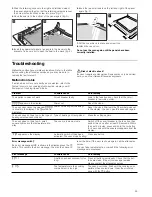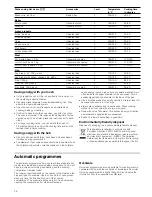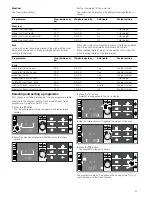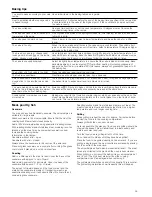
38
Tips for roasting and grilling
Slow cooking
Slow cooking, also known as low-temperature cooking, is the
ideal cooking method for tender pieces of meat that are to be
cooked medium rare or à point. Meat remains very succulent
and tender.
The benefit of this cooking method is that it allows lots of scope
for menu planning because slow-cooked meat is easy to keep
warm.
Notes
■
Only use fresh, good-quality meat. Carefully remove sinews
and fat from around the edge. Fat develops a strong, distinct
taste during slow cooking.
■
Larger pieces of meat do not need to be turned.
■
Meat can be carved immediately following slow cooking. No
standing time is required.
■
Due to the special cooking method, the meat looks pink, i.e.
medium rare. This does not mean, however, that it is raw or
not well done enough.
■
If you want to make gravy, cook the meat in ovenware with a
lid. Please note that the cooking times will be reduced.
■
In order to check whether the meat is cooked, use a meat
thermometer. A core temperature of 60 °C should be
maintained for at least 30 minutes.
Suitable ovenware
Use shallow ovenware, e.g. a porcelain serving plate or an
glass roasting dish without the lid.
Always place the uncovered ovenware on the wire rack at
level 2.
Making settings
1.
Select
%
Top/bottom heating and set a temperature between
70 and 90 °C.
Preheat the oven, placing the ovenware inside it to warm.
2.
Rapidly heat a little fat in a pan. Sear the meat on all sides,
even on the ends, and place immediately on the preheated
ovenware.
3.
Put the ovenware containing the meat back in the oven and
slow cook. A slow-cook temperature of 80 °C is ideal for
most pieces of meat.
Table
All tender joints of poultry, beef, veal, pork and lamb are
suitable for slow cooking. The slow cooking times depend on
the thickness and the core temperature of the meat.
The table does not contain information
for the weight of the joint.
Select the next lowest weight from the instructions and extend the time.
How to tell when the roast is ready.
Use a meat thermometer (available from specialist shops) or carry out a “spoon test”.
Press down on the roast with a spoon. If it feels firm, it is ready. If the spoon can be
pressed in, it needs to be cooked for a little longer.
The roast is too dark and the crackling
is partly burnt.
Check the shelf height and temperature.
The roast looks good but the juices are
burnt.
Next time, use a smaller roasting dish or add more liquid.
The roast looks good but the juices are
too clear and watery.
Next time, use a larger roasting dish and use less liquid.
Steam rises from the roast when basted. This is normal and due to the laws of physics. The majority of the steam escapes through
the steam outlet. It may settle and form condensation on the cooler switch panel or on
the fronts of adjacent units.
Dish
Weight
Level
Type of
heating
Temperature
in °C
Searing time
in minutes
Slow cooking
time in hours
Poultry
Turkey breast
1000 g
2
%
80
6-7
4-5
Duck breast*
300-400 g
2
%
80
3-5
2-2½
Beef
Joint of beef (e.g. rump) 6
7 cm
thick
approx. 1.5 kg 2
%
80
6-7
4½-5½
Tenderloin, whole
approx. 1.5 kg 2
%
80
6-7
5-6
Sirloin, 5
6 cm thick
approx. 1.5 kg 2
%
80
6-7
4-5
Steak-cut rump, 3 cm thick
2
%
80
5-7
80-110 Min.
Veal
Joint of veal (e.g. topside),
6-7 cm thick
approx. 1.5 kg 2
%
80
6-7
5-6
Fillet of veal
approx. 800 g
2
%
80
6-7
3-3½
Pork
Pork joint, lean (e.g. loin), 5-6 cm
thick
approx. 1.5 kg 2
%
80
6-7
5-6
Fillet of pork, whole
approx. 500 g
2
%
80
6-7
2½-3
* For crispy skin, briefly fry the duck breast in a frying pan after slow cooking.
Содержание HCE8584.1A
Страница 1: ... en Instruction manual Free standing cooker HCE8584 1A ...
Страница 2: ......







































